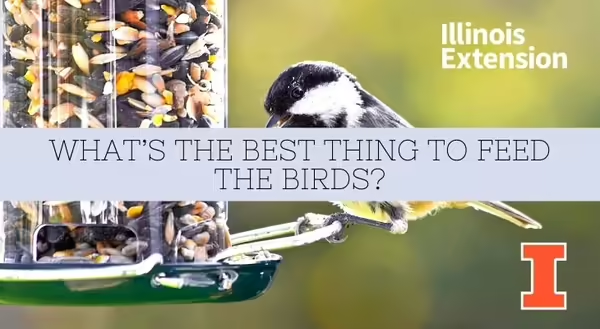
People love to feed birds. Aside from gardening, it is considered one of the most popular hobbies around the globe. And even some would argue, feeding the birds is a part of gardening. In the winter months, many find joy in watching a flurry of feathered friends, feeding at the feeder. The bird food we set out helps to give those birds that stick around Illinois over the winter an energy boost to keep their body temperatures up on these cold days.
Whether you are new or a veteran of feeding the birds, many often ask – What is the best bird food? Now the answer to that question depends on what your goals are for the feeder. What species do you want to attract? Are you going to be active in keeping up the feeder? And what are you willing to spend to feed the birds?
Picking the best bird food
Stores that sell bird food can offer lots of choices of seed mixes. Making the process of feeding the birds a bit confusing. Feeding birds does not have to be overly complicated. I recommend keeping it simple. Let’s look at some of the individual ingredients commonly found in birdseed mixes to see what may work best for your situation.
Black-oiled sunflower seed is attractive to the greatest variety of birds overwintering in Illinois. With a thin shell and energy-rich seed, black-oil sunflower seed can easily be consumed by many bird species. When it comes to simplicity, setting out only sunflower seed is about as easy as it gets.
You can also get hulled sunflower seed which is essentially black-oiled sunflower without the seed shell. If you have set out sunflower seed you’ve likely experienced a mess that occurs under the feeder as birds split open the shell and drop it to the ground. Hulled sunflower seed cuts down on the debris found under the feeder. Since there’s no shell to get in their way, it is very attractive to birds. Of course, this comes with a higher price tag and a greater risk of seed spoilage.
Millet is a small round grain that is good for ground-foraging birds such as juncos and sparrows. With a small bag of millet, it is simple to toss a handful of it on the ground below the feeder every so often. To attract larger ground-feeders like quail and doves, try mixing in some cracked corn to the millet.
Nyjer seed has become popular as it is attractive to the coveted American goldfinch. Because Nyjer seed is so small, it does require a special feeder with smaller openings. To avoid waste it is recommended to not mix Nyjer seed with other birdseed.
Milo is similar in appearance to millet, but this is not a favored seed for overwintering Illinois birds. Milo is often considered a filler ingredient in many inexpensive seed mixes. Illinois birds will typically avoid eating milo and leave it behind in the feeder or on the ground. Therefore, I avoid it too.
Suet is my favorite thing to leave out for birds in the winter. I enjoy watching the different species it attracts, including the cling feeders like woodpeckers. Commercial suet comes in cakes comprised of beef kidney fat. Recipes vary from there and mixed within the cake can be found all types of seed, nuts, and berries in various combinations.
If you were to poke your head in my backyard, you’d find only black oiled sunflower seed on a platform feeder and cages of suet feeders hung throughout the landscape. It may be simple, but it still puts on quite a show for these winter months.
Good Growing Tip of the Week: Prevent fatal bird strikes caused by your windows. Place bird feeders close (within 3 feet) or farther away (10 feet or farther) from your home.
Do you want to turn your backyard into a winter bird haven? Then check out my YouTube video on how you can bird-scape around your home.
Reference (and highly valuable resource): Cornell's Project FeederWatch https://feederwatch.org/learn/feeding-birds/
Sign up for our emails! Want to get notified when new Good Growing posts are available? SIGN ME UP
Give us feedback! How helpful was this information (click one): Very helpful | Somewhat helpful | Not very helpful
MEET THE AUTHOR
Chris Enroth is a horticulture educator with University of Illinois Extension, serving Henderson, McDonough, Knox, and Warren counties since 2012. Chris provides horticulture programming with an emphasis on the home gardener, landscape maintenance personnel, and commercial landscapers. Additional responsibilities include coordinating local county Master Gardener and Master Naturalist volunteers - providing their training, continuing education, advanced training, seasonal events, and organizing community outreach programs for horticulture and conservation assistance/education. In his spare time, Chris enjoys the outdoors, lounging in the garden among the flowers (weeds to most).